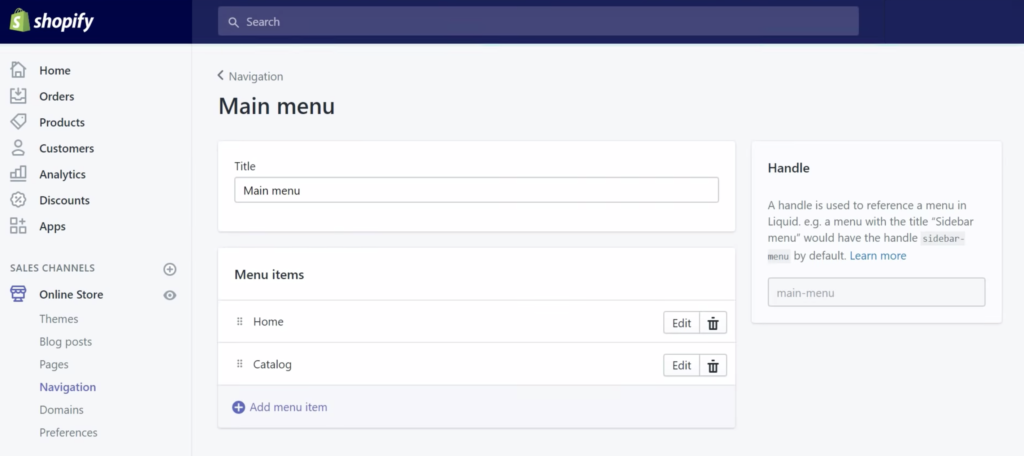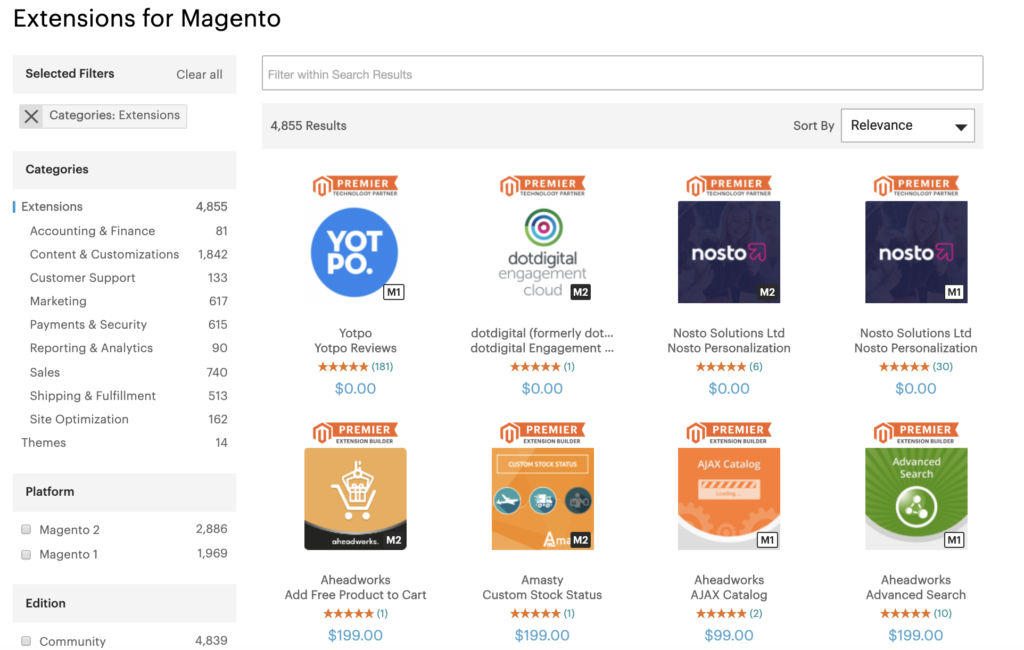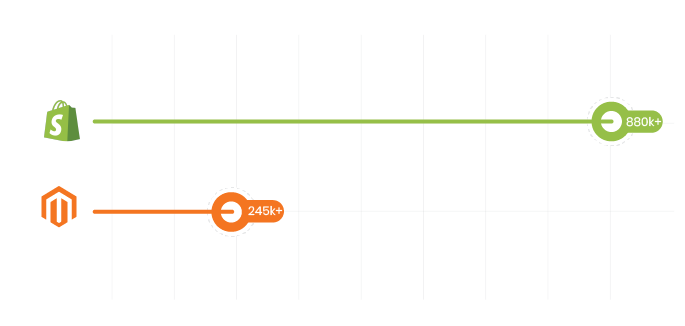Which eCommerce Platform Is Best?

At the center of these questions is an answer to which platform will do everything you want, while still being cost effective and providing the customer experience you’re looking for? Two of the main contenders are Magento and Shopify.
While both are able to create unique eCommerce stores, they differ significantly in almost all areas. As we’ll look at in more detail, Magento and Shopify have two different target audiences. Magento is aimed at larger, enterprise businesses, while Shopify is designed around small businesses looking for simple site creation.
We’ll explore several different areas and ask which platform is best for merchants in what ways. This article will try to answer:
- How do Shopify stores work?
- Can Magento handle millions of products?
- Are Shopify stores SEO friendly
- Why is Magento secure?
- What is the final price of Magento?
- Which is better: Magento or Shopify?
Contents
In Numbers Pros vs Cons Design and Templates Ease of UseFunctionality Extensions and Apps Inventory Performance SEO Security Pricing
Magento vs Shopify: In Numbers
When it comes to numbers, Magento and Shopify couldn’t be more different.
In terms of number of sites, Shopify boasts over 880,000, which dwarfs the 245,000 Magento sites currently live.
Yet if we take a look at the percentage of those sites that have made it into the top 1m and top 10k sites, we begin to see a different picture.
According to BuiltWith, 6.2% of Magento sites are featured within the top 1m sites globally, compared with just 2.51% being sites that operate on Shopify. This trend continues into the top 10k sites, with 0.07% of Magento stores featured, compared with just 0.05% of Shopify sites.
This suggests that Magento is more likely to support enterprise level stores that are able to better hone in on personalized customer experiences.
As we will dive into later in this article, Magento is known for its incredible functionality and ability to customize the eCommerce experience. So it’s no surprise that larger online stores lean towards using it.
| Magento | Shopify | |
| Number of sites | 245,000 | 880,000 |
| Number of extensions or apps | 4,700 | 2,500 |
| Monthly Cost | $0* | $29 – $2,000+ |
* Requires a hosting solution, which normally starts at around $29 per month.
Magento vs Shopify: Pros and Cons
Magento Pros
Functionality
Magneto offers incredible functionality compared to almost any other eCommerce platform out there. This makes it one of the most versatile options for merchants looking to create personalized customer experiences, especially if they have a developer team behind them.
Advanced Shopping Cart Options
Shopping cart customization can make all the difference in terms of real ROI. As one of the most vital stages of a customer’s journey, the right options during purchase can be the difference between clicking cross and clicking buy.
Extension Expandability
Magento has almost twice the number of extensions as Shopify. And it’s not just quantity either. Magento extensions stay true to the platform’s reputation for flexibility by providing more in terms of functionality.
Great Community
An asset that is not talked about enough. Magento’s community provides the eCommerce web application with a lot of support that other non-open-source applications don’t receive.
Magento Cons
Difficult for Beginners
Magento was not designed for those looking to take their first steps into eCommerce. While there is a page builder in the works for open source, you still very much need either coding knowledge or a developer to get started.
Cost
While open source itself is free, hosting is not. This can cost many hundreds of dollars if you’re a large store. It can cost you more than the Shopify equivalent, but we would argue that you get more for your money by self hosting.
Shopify Pros
Ease of Use
Shopify is designed to be a simple eCommerce platform that provides owners with an easy way to get started selling quickly. Pages can be easily customized, as can products. While this customization is nowhere near Magento’s, it’s enough to get started.
Free Themes
Shopify has several free themes available to get started with. They require no coding, are responsive, and look modern.
Inclusive
Shopify is all managed through a single point of contact. Instead of having to manage your store on multiple fronts, you’re able to access and do everything in one place.
Price
Once you’ve gone through all the additions you’ll have to add to your Magento budget, Shopify is often the more inexpensive option.
Shopify Cons
Transaction fee per sale
Each time you sell a product, you pay Shopify. With the basic plan, this starts from 2.9% + 30¢ per sale. If you use an external payment gateway, you can add an additional 2%. Learn more about Shopify’s transaction fees.
Lacks Functionality
As we’ll explore in this article, Shopify just can’t compete with Magento in terms of functionality.
Designs and Themes
In terms of design, both Magento and Shopify hold their own. From the get-go, Shopify does offer a better experience for beginners. The stock themes available come in both free and paid flavours, and provide a classy, modern look.
Shopify’s themes can also be tweaked to line up with your brand image. These tweaks can include, but are not limited to:
- Changing color schemes throughout the site
- Applying custom images to products and pages
- Changing how newsletter signups work
- Editing the action bar and navigation text
Mobile responsiveness is now more vital than ever. 79% of mobile users made a purchase with their mobile in 2018. For merchants, this means it’s important that their site looks good and offers a great user experience on mobile.
Both Magento and Shopify offer responsive templates by default. However, if you’re willing and able to develop your own eCommerce store, Magento really shines.
Creating your own theme in Magento can be a long process that requires coding knowledge. However, the rewards are multitude. A customized Magento build allows you to create a storefront unlike anything offered in Shopify.
This includes:
- Cross-selling and up-selling blocks throughout your site
- Advanced search functionality with tools like Elasticsearch
- Featured product sliders and hero carousels
- Expanded footer functionality including newsletter sign-ups
- Advanced cart and payment integration
Which platform is better really depends on what you want to do with it and your experience level. Shopify is great for beginners, but Magento offers more experienced users a wealth of design and theme options you just won’t find in simpler eCommerce applications.
Winner: Draw
Ease of use
Straight out of the gate, Shopify takes the lead. Known for its ease of use and ability to create simple, easy to navigate online stores. It, without a doubt, is the easier application for merchants.
Shopify also features an easy to use drag and drop interface. This is something you won’t find in Magento and makes creating new pages much easier.

Shopify makes store creation simple with an easy to navigate admin interface.
However, with that simplicity comes a lack of versatility. Versatility that can be found and taken advantage of with Magento.
Besides offering a host of built-in customizations and functionalities, Magento also offers an extension marketplace with over 4,700 extensions available to download and add to your store.
Additionally, Magento’s recent acquisition by Adobe has already led to other added functionality and integrations for the eCommerce application. Integrations that Shopify simply can’t compete with for enterprise level clients.
If you’re looking for ease of use, Shopify is the way to go. However, if you’re willing to put in the time and energy needed to learn and adapt a Magento store’s customer experience, Magento is the application you should stay behind.
Winner: Shopify
eCommerce Functionality
Magento is known as an eCommerce powerhouse. Between built-in functionality and add-on extensions, it stands as one of the most adaptable eCommerce platforms available.
Yet Shopify does offer enough functionality for small and medium businesses to grow. The eCommerce application makes it easy to do a lot of things without having to code even a single line.
This includes:
- Inserting custom images to create a personalized experience
- Adding products and SKUs to your store
- Setting up optimized payment options
- Customizing the customer experience and the look and feel of your store
However, as you start to require more advanced functionality, your monthly premium will increase. You’ll have to pay more than $29 a month if you want to use gift cards, build professional reports, and implement advanced shipping options.
Magento, on the other hand, is engineered to allow merchants full control of the customer experience by default. This means creating and selling fully customizable products and managing them across multiple stores (if needed).
Shopify does offer a limited number of translation apps, but they don’t provide the complete experience like Magento can.
Magento wins here. But we knew that before we even started.
Winner: Magento
Apps and Extensions
Once you’ve got your store up and running, you may find that some functions and features you want are missing. Advanced checkout, improved search, and expanded payment options, as a few examples.
Both applications have an answer to this, and it comes in the form of 1-click add-ons that can be purchased (in some cases), downloaded, and installed. Shopify call these Apps, Magento calls them Extensions.
Delving into the options available to merchants, it’s easy to see why Magento’s marketplace is praised, where Shopify’s app store is seen as more of a useful addition.
The first thing you might notice is the difference in the number of extensions made available for each. The Magento marketplace offers over 4,700 extensions, almost double Shopify’s 2,500. And it’s not just the quantity of add-ons that make Magento so much more versatile, it’s the quality as well.
Shopify apps allow users to:
- Integrate their store with social and shopping channels
- Add additional shipping options
- Make basic edits to SEO important data
Magento extensions make it possible to:
- Add advanced pre-order functionality
- Draw insightful analytics into how well a product is doing
- Integrate marketing and analytics software into the eCommerce platform
- Leverage powerful advertising tools both internally and externally.
A comparison of some of the more popular add-ons for each, shows that Magento truly is aimed towards delivering a custom user experience and that its extension marketplace only aids in doing so.

Magento |

Shopify |
| Yotpo Reviews | Facebook Channel |
| Amasty Improved Layered Navigation | Instagram Channel |
| Amasty Customer Attributes | Oberlo |
| Aheadworks Ajax Cart Pro | Point of Sale |
| Aheadworks Add Free Product to Cart | Messenger Channel |

Magento extensions can be found on the Magento marketplace.
Unfortunately, Magento’s extensions (in general) are costly compared with Shopify’s apps. Moreover, Shopify offers a lot more in terms of free add-ons.
Magento is the clear winner here. Despite costing more, the extensions available add more in-depth functionality and there’s a much larger range.
Winner: Magento
Inventory Size
Both eCommerce platforms allow for an unlimited number of products. They also both allow for you to integrate shipping and fulfilment extensions into your store so that inventory management is easy.
However, the larger your store becomes with Magento, the more likely you are to run into performance problems if you don’t upgrade your hosting account. Shopify has similar problems. However, because your store will be hosted by Shopify themselves, they will encourage you to upgrade your account before you start to experience slowdowns.
With Magento, we recommend finding a Magento-optimized hosting provider, as they will provide you with a fully managed service, similar to Shopify. In some cases, you may even find that your store is faster and more reliable than its shopify counterpart.
Shopify still wins this round, simply because it’s easier to manage performance and inventory through one point of contact, instead of having to get in touch with a developer, hosting provider, and the Magento community.
Winner: Shopify
Performance
Magento is a known resource hog, requiring a serious hosting environment to back it up. It’s common knowledge that a merchant’s hosting infrastructure can start to feel the strain as more product SKUs are added. Backed by over a decade of experience, we offer an optimized Magento solution that uses caching to improve the performance of Magento stores. Many of those optimizations you won’t find elsewhere.
Shopify, on the other hand, is a lightweight application. As a result, it runs quickly in most environments, and can hold a larger number of product SKUs on the same hardware that will only run a smaller Magento store.
However, Shopify doesn’t have the same level of functionality as Magento. Personalized shopping experiences with Shopify can be as much as occasional product recommendations and cross-selling.
The reason Magento is such as resource hog is because of everything going on behind the scenes. True personalization of the commerce experience with cross-selling, up-selling, customized shopping cart experiences, and more.
And Magento will run smoothly if the server is configured properly. In 2018, we saw 64% of our hosting solutions run Magento. When asked why they chose us for Magento, merchants cited uptime and functionality as the two main factors at play. Indicating that performance did have a part to play.
Magento scrapes by as the winner here. While Shopify requires less optimization, Magento reigns champion due to the added functionality that comes with it. Moreover, with customized customer experiences, it’s almost certain a Magento store will perform better in terms of ROI.
Winner: Magento
SEO
Both Magento and shopify are strong SEO contenders. In some research, Shopify comes out on top with an SEO score of 98, compared with Magento’s 95.
However, while Shopify is better from an absolute beginner perspective, those with some SEO knowledge will be able to get more out of a Magento installation. The primary reason for this is the extensions available and the ability to truly conform to coding best practices.
Magento doesn’t just let you edit metadata, it also allows you to make vital product and on-page customizations that can provide you with an SEO boost you won’t find in a SaaS product. Additionally, if you’re looking to start working in SEO longtail, adding a WordPress blog to your Magento store is a relatively simple process.
We’re setting Magento as the winner here, due in large part to the added customization options available for users and the ability to customize the SEO process manually.
Winner: Magento
Security
Security should be at the top of your list. According to the State of Hosting, 61% of shoppers will not purchase from a site that is missing a trust seal such as an SSL certificate.
With changes to the way Google handles security, sites that lack an SSL certificate will now be subject to unsecured site warnings before shoppers can proceed. 98% of shoppers will not proceed past these warnings.
While Shopify manages the integration of an SSL certificate, Magento requires you to purchase and install one separately. This process can be managed for you by a managed hosting provider, but you’ll need to find one first.
In terms of updates and patches, Shopify manages them for you. Magento requires you to do this manually. While Magento’s method requires more time investment from the merchant or developer team, it also provides more flexibility. This is, in large part, due to the incredible community behind Magento.
Magento frequently releases dedicated security patches that are the result of constant testing and development by a community of developers well-versed in the requirements of eCommerce stores.
Shopify, on the other hand, is only managed by in-house talent. This makes for a much smaller pool of resources working on creating and deploying fixes for security problems. While there is a Shopify bounty program that rewards users who find vulnerabilities, the fixes themselves are internal.
Finally, in order for merchants to process credit card data, it’s important for them to be PCI compliant. Shopify, again, manages this internally. However, once again, finding the right Magento hosting provider will make managing PCI compliance just as easy.
Magento is the winner here. While it’s true that Shopify makes security easier, Magento community support can’t be matched. Moreover, by searching for and finding the right hosting provider, managing security with Magento can be just as easy while still providing flexibility you won’t find with a SaaS platform.
Winner: Magento
Pricing
A quick look at the pricing for each eCommerce platform makes it seem as though Magento is the cheaper option. However, while Magento open source itself is free, there are numerous hidden costs.
As a Magento merchant, you have to consider hosting costs, security costs (such as SSLs), and developer fees. Developer fees can be the largest, with some Magento stores costing several thousand dollars in terms of development.
If you’re looking for a cheaper option, Shopify is the better choice. It’s also a lot more predictable, with a clear, monthly payment in addition to a transaction fee per sale.
Winner: Shopify
Magento vs Shopify: The Winner
So when it comes down to it, which is better: Magento or Shopify?
We’ve come to the conclusion that it really depends on what you’re looking for. Magento is better for those looking to create personalized customer journeys that visitors won’t find anywhere else. Shopify is good for merchants looking to create an eCommerce site with little coding or technical experience behind it.
If you do have either the technical experience or a team of developers, we highly recommend Magento. With functionality you just can’t find anywhere else, and an open source version driven by an incredible community, it’s hard to beat.
If, however, you don’t have the time or money to invest in creating these unique experiences, Shopify is going to leave you with a better storefront that serves customers that information they need.





